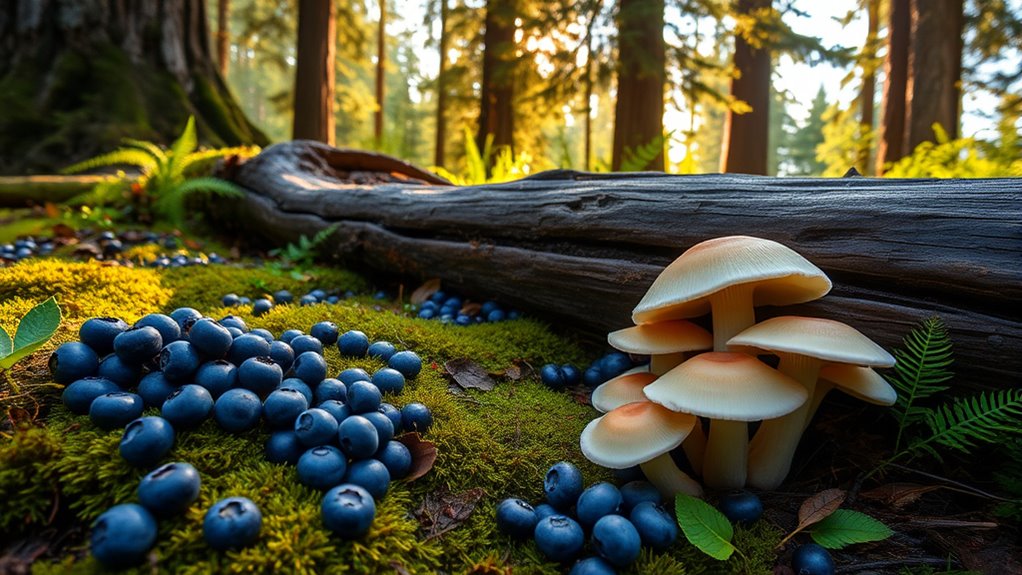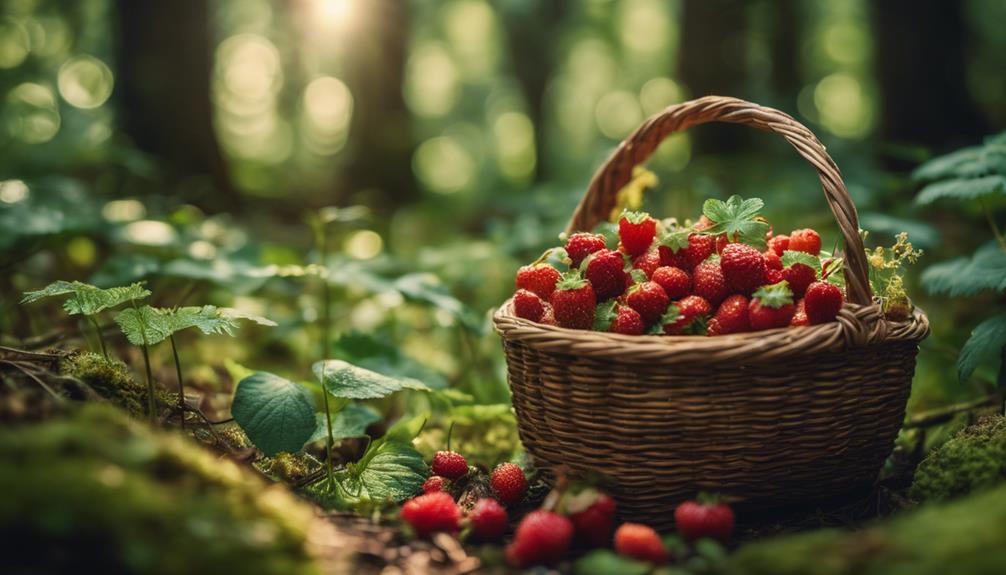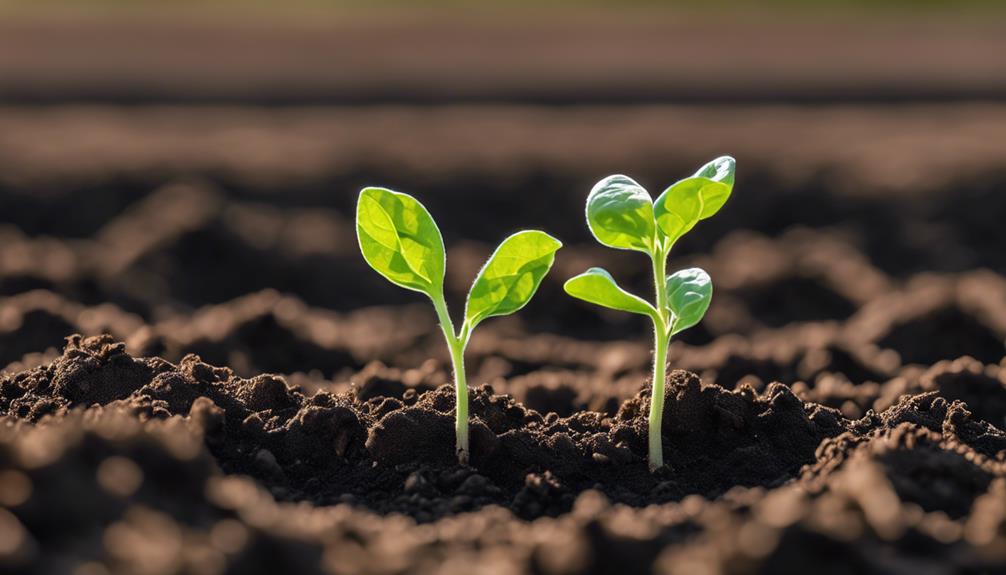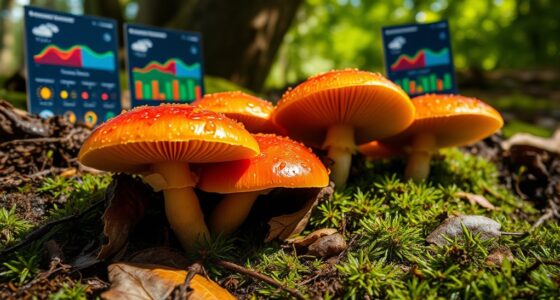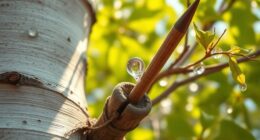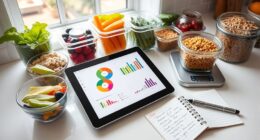A foraging guide to the Pacific Northwest helps you safely identify and harvest wild edible plants like blackberries, camas, and mushrooms. It highlights key features, seasonal cues, and habitat tips to distinguish safe foods from toxic look-alikes. Responsible foraging practices emphasize sustainability and respecting regulations. To truly master regional wild foods, you’ll find detailed identification tips, ecological insights, and safety advice that make your foraging trips more successful—continue exploring to uncover more expert strategies.
Key Takeaways
- Learn to identify edible native plants and invasive species using reliable resources like *Northwest Foraging* and visual cues.
- Follow sustainable foraging practices, including respecting regulations, harvesting responsibly, and protecting ecosystems.
- Focus on region-specific wild edibles such as berries, mushrooms, and roots, with seasonal cues for optimal harvesting times.
- Be aware of toxic look-alikes like false hellebore and water hemlock, and verify identifications carefully.
- Expand your knowledge with additional resources on regional flora, ecology, and cultural uses to enhance safe foraging.
Essential Books for Beginners in the Pacific Northwest
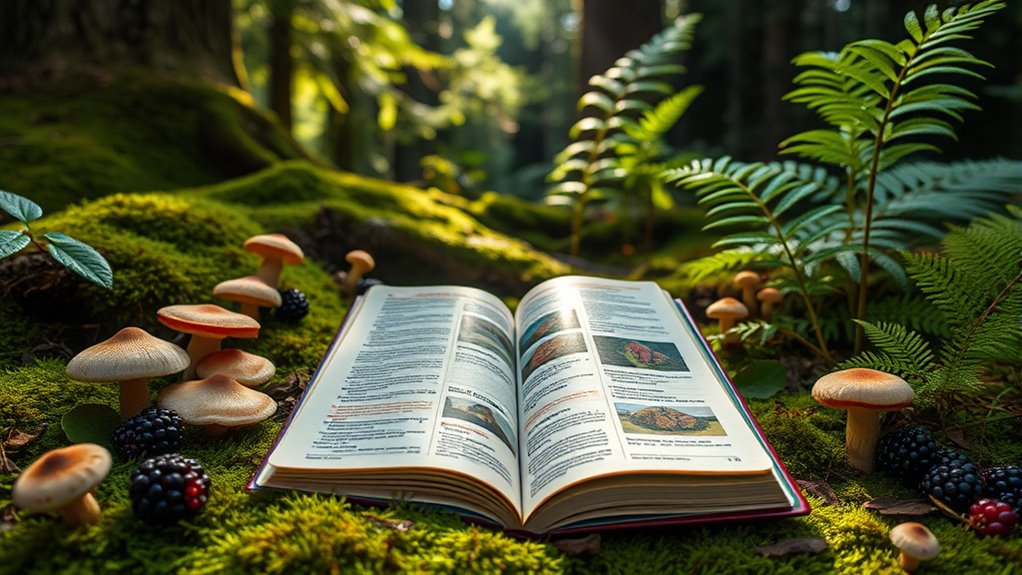
If you’re new to foraging in the Pacific Northwest, starting with the right books can make all the difference. Foraging books like *Northwest Foraging* by Doug Benoliel provide detailed plant descriptions, illustrations, and safety tips, making edible plants easier to identify. Many beginners find *Pacific Northwest Foraging* by Douglas Deur especially helpful because it highlights easy-to-identify wild edibles such as blackberries, lilies, and knotweed, perfect for novices. These field guides focus on region-specific edible plants, helping you recognize safe wild edibles while avoiding lookalikes. Additionally, understanding the foraging range of local species can help you plan effective harvesting trips and find abundant resources nearby. Learning about the seasonality of various plants can also improve your success rate in harvesting at the right time for peak flavor and safety. Incorporating knowledge of plant habitats can further enhance your ability to locate diverse and sustainable food sources. Recognizing the growth patterns of different plants can assist in sustainable harvesting practices and ensure the longevity of these wild food sources. Additional books like *Northwest Edible Plants* offer practical advice on harvesting, drying, and storing wild foods. Combining these resources builds your confidence and skills, giving you a solid foundation in safe, effective foraging across the Northwest.
Key Features of Northwest Foraging: A Trusted Classic
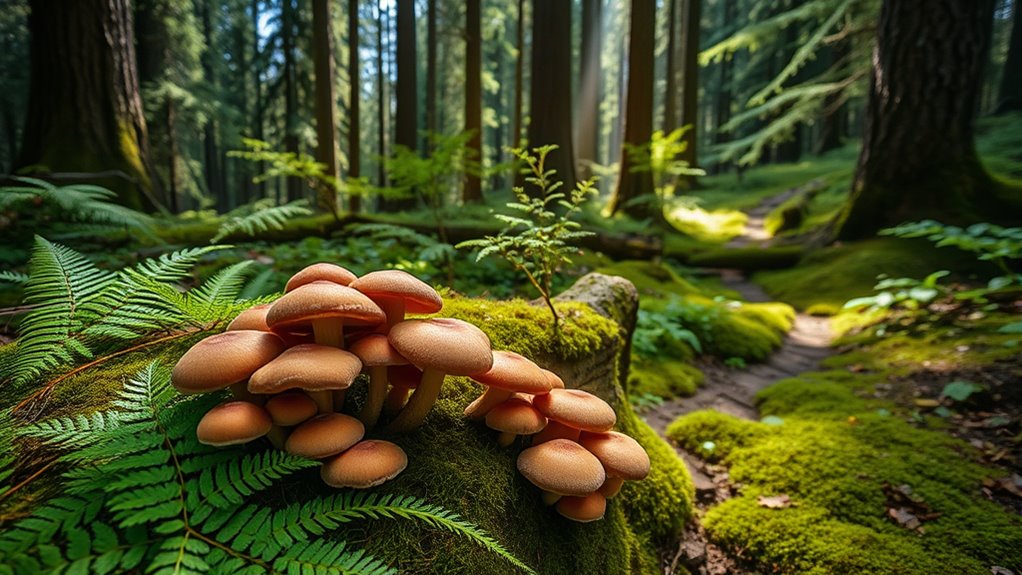
*Northwest Foraging* stands out as a trusted classic because of its all-encompassing approach to identifying edible plants in the Pacific Northwest. It offers detailed black-and-white line drawings by Mark Orsen, illustrating over 50 key foraging plants and highlighting their best harvesting stages. The guide combines practical guidance with thorough plant descriptions, habitats, seasonal cues, and Native American uses, making it a well-rounded resource. Its clear organization and accuracy ensure it remains dependable for both beginners and seasoned foragers. Despite being an older publication, *Northwest Foraging* continues to be a foundational text, highly recommended for its thoroughness and enduring trustworthiness. It’s an essential reference that combines visual aids with comprehensive information, making foraging safer and more informed. Additionally, the guide emphasizes reliable identification methods to prevent misidentification and ensure safe harvesting. Its emphasis on plant habitat and seasonal cues helps foragers time their collection correctly and avoid confusion with look-alike species. Incorporating local environmental conditions further enhances the accuracy of plant identification and harvest timing. Furthermore, understanding conservation practices is crucial for sustainable foraging and preserving native plant populations. Being aware of seasonal variations can also assist foragers in selecting the optimal times for harvesting different plants.
Identifying Edible Plants: Tips and Visual Aids
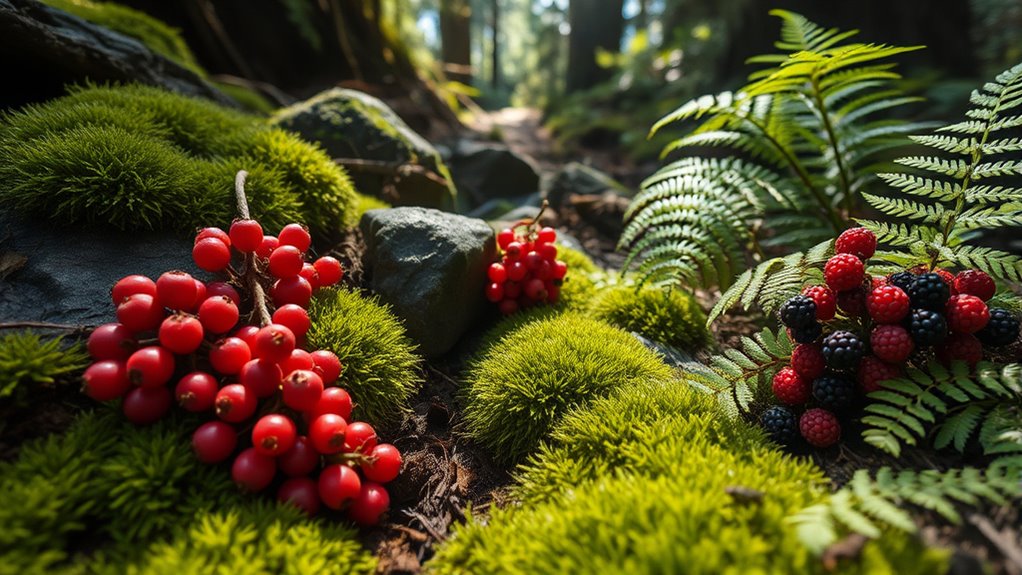
Accurately identifying edible plants requires paying close attention to specific visual features and contextual clues. Focus on leaf shape, flower structure, and fruit characteristics to tell edible plants apart from look-alikes. Refer to seasonality charts to know the best harvesting times, which helps avoid confusion. Use black-and-white line drawings to highlight key identification features, but supplement these with color photos for better comparison. Pay attention to the plant’s habitat and growth environment, including soil type and nearby plants, to confirm your identification. Always verify multiple visual cues before harvesting, especially when poisonous look-alikes exist. Incorporating visual aids like detailed descriptions, environmental context, and proper maintenance practices ensures you confidently and safely identify edible plants in the Pacific Northwest. Additionally, understanding the plant’s growth habits can help distinguish it from similar but inedible species. Recognizing hunting and foraging practices in the region can also improve your identification skills and safety. Familiarizing yourself with common poisonous look-alikes can prevent dangerous mistakes and enhance your foraging confidence.
Responsible and Sustainable Foraging Practices

When foraging, make sure you harvest only what you need and use proper techniques to protect plant health and local ecosystems. Learn to identify poisonous and protected species to avoid accidental harm or legal issues. Supporting conservation efforts and respecting regulations helps guarantee sustainable foraging for future generations. Additionally, understanding Halloween traditions can enhance your seasonal appreciation and promote responsible celebrations. Being aware of biodiversity hotspots can also guide you to richer foraging sites that support a diverse range of species. Incorporating knowledge of native plant species can further improve your sustainable harvesting practices and support local biodiversity. Recognizing personality traits that influence decision-making can help improve your foraging strategies and interactions with others. Practicing ethical foraging ensures that we minimize our impact on vulnerable populations and maintain ecological balance.
Harvesting Respectfully and Moderately
To guarantee sustainable foraging, it’s essential to approach harvesting with respect and moderation. Always take only what you need, avoiding overharvesting that could harm local plants and ecosystems. Practice moderation by leaving plenty of mature plants behind so they can reseed and regenerate naturally. Use clean, sharp tools to carefully harvest, which minimizes damage to the plant and surrounding environment. Be mindful of sensitive habitats and avoid collecting from rare or endangered species to prevent further decline. Follow local regulations and obtain any necessary permits to ensure you’re foraging legally and responsibly. Engaging in sustainable harvesting practices helps protect the plants and ecosystems you enjoy, ensuring future foragers can also benefit from the bounty of the Pacific Northwest. Understanding the implications of electric bikes’ horsepower can also inform how we develop sustainable practices and policies for natural resource management. Additionally, assessing merchant service risks can help ensure that your foraging business remains secure and compliant with evolving regulations.
Identifying Poisonous and Protected Species
How can you guarantee you’re foraging safely and responsibly? First, verify plant identification with multiple sources, as many edible plants have toxic look-alikes, like false hellebore mimicking edible lilies. Be aware that certain native species, such as Western Trillium and Oregon Grape, are protected by law; harvesting them harms their populations. Learn to recognize poisonous plants like Death Camas and Water Hemlock, which contain dangerous toxins that can cause severe illness or death. Practice sustainable foraging by only taking abundant plants, leaving mature specimens to regenerate, and avoiding protected or sensitive habitats. Always check local regulations and guidelines, since many parks restrict or prohibit foraging of specific species to preserve ecosystems. Responsible foraging protects both your safety and the environment.
Supporting Local Conservation Efforts
Building on the importance of responsible foraging, supporting local conservation efforts guarantees that wild edible plants remain abundant for future generations. You can do this by harvesting only what you need and avoiding overharvesting, which helps keep plant populations healthy and ecosystems balanced. Following local regulations and obtaining permits protect native species and fragile habitats across the Pacific Northwest. Educating yourself about poisonous plants and invasive species ensures you don’t inadvertently harm native flora, supporting biodiversity. Practice selective harvesting—take only parts of a plant and leave enough behind to promote regrowth. Additionally, participating in community foraging programs and advocating for habitat protection initiatives help preserve wild edible plant populations, ensuring these resources stay sustainable and available for everyone.
Regional Highlights: Wild Edibles to Know in the Pacific Northwest
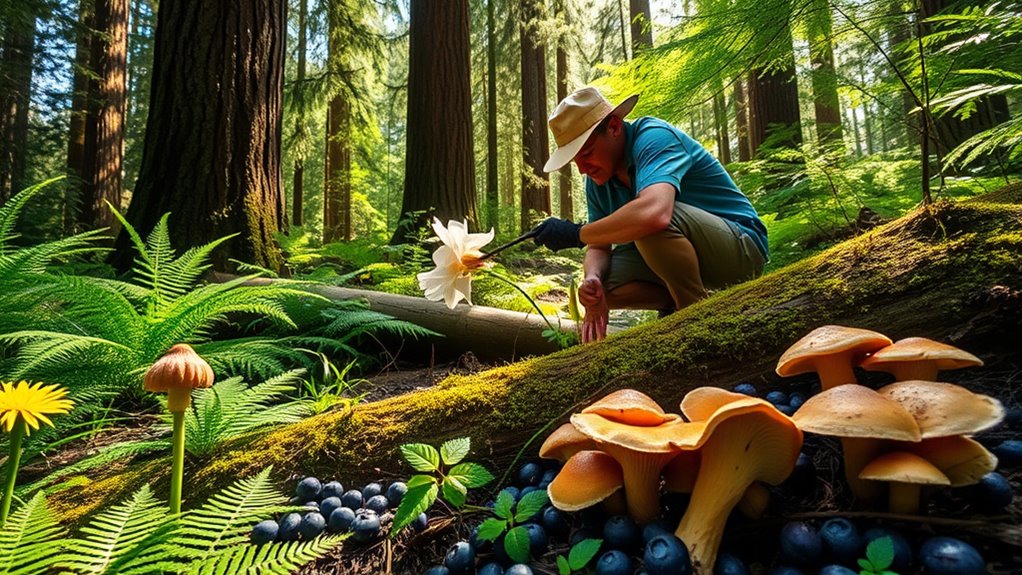
The Pacific Northwest offers a diverse array of wild edibles that are both abundant and easy to identify for experienced foragers. Salmonberries, Oregon grapes, and wild mushrooms like chanterelles and matsutake grow plentifully across forests and meadows. Indigenous communities have long used native plants such as camas bulbs and bittercress for culinary and medicinal purposes. Seasonal cues, like elderberries blooming in late summer, guide you to prime harvest times. In forests and along streambanks, you’ll find wild thistles, nettles, and fiddlehead ferns, each with distinct flavors. Urban margins and streamside areas also host edible plants like Japanese knotweed and Himalayan blackberries, offering foraging opportunities beyond wildlands. These highlights make the Pacific Northwest a vibrant region for discovering wild foods.
Additional Resources and Recommended Reads

To deepen your understanding of the region’s plants and their cultural significance, exploring a variety of books and resources can be incredibly valuable. “Pacific Northwest Medicinal Plants” offers detailed profiles of native herbs used traditionally for healing, complementing your foraging knowledge with medicinal insights. Robin Wall Kimmerer’s “Braiding Sweetgrass” blends indigenous wisdom with ecological awareness, enriching your connection to plant-human relationships. “Backyard Bounty” provides practical advice for growing and foraging native and adapted plants, making it easier to incorporate wild edibles into your garden. “Too High and Too Steep” explores the history and ecology of the Cascade Mountains, offering valuable context for regional plant habitats. Finally, “A Puget Sound Orca in Captivity” shares ecological stories that deepen appreciation for local wildlife and native plant environments.
Frequently Asked Questions
What Is the 1 3 Rule for Foraging?
The 1-3 Rule for foraging advises you to harvest only one-third of a plant or its parts. By doing this, you guarantee the plant can recover and continue thriving. You should observe the plant’s growth and reproductive cycle, choosing the right season for harvest. This practice helps protect wild populations, supports sustainable foraging, and maintains ecological balance, ensuring future harvests and healthy ecosystems.
What Is the Number One Rule of Foraging?
The number one rule of foraging is to always positively identify every plant before you harvest or eat it. You need to be 100% sure it’s safe, avoiding any that could be poisonous or toxic. Never rely on guesswork, folklore, or hearsay. Take your time, use reliable resources, and if you’re unsure, leave it alone. This guarantees your safety and helps protect the environment.
What Is the Best Book on Foraging?
Did you know that over 300 edible plants grow naturally in the Pacific Northwest? When asked about the best foraging book, you should go with *Northwest Foraging* by Doug Benoliel. It’s praised for its detailed descriptions, illustrations, and regional focus. You’ll find practical tips, native uses, and seasonal cues that make identifying and harvesting plants safer and easier, perfect for both beginners and seasoned foragers.
How Do Beginners Do Forage?
As a beginner, you should start by learning a few easy-to-identify edible plants like wild berries, dandelions, or miner’s lettuce. Use a clear, beginner-friendly guide with photos to help with identification. Forage in familiar, low-traffic areas to reduce risks and environmental impact. Always double-check your finds with multiple sources and consult local experts. Practice responsible harvesting to develop good habits and avoid harming protected species.
Conclusion
Armed with this guide, you’re ready to unveil the Pacific Northwest’s wild bounty. Think of it as your treasure map, leading you through lush forests and vibrant meadows. With responsible foraging and sharp eyes, you’ll turn nature’s secrets into delicious discoveries. Remember, every plant is a story waiting to be told—respect it, learn from it, and let your adventures bloom like the wildflowers in spring. Happy foraging!

